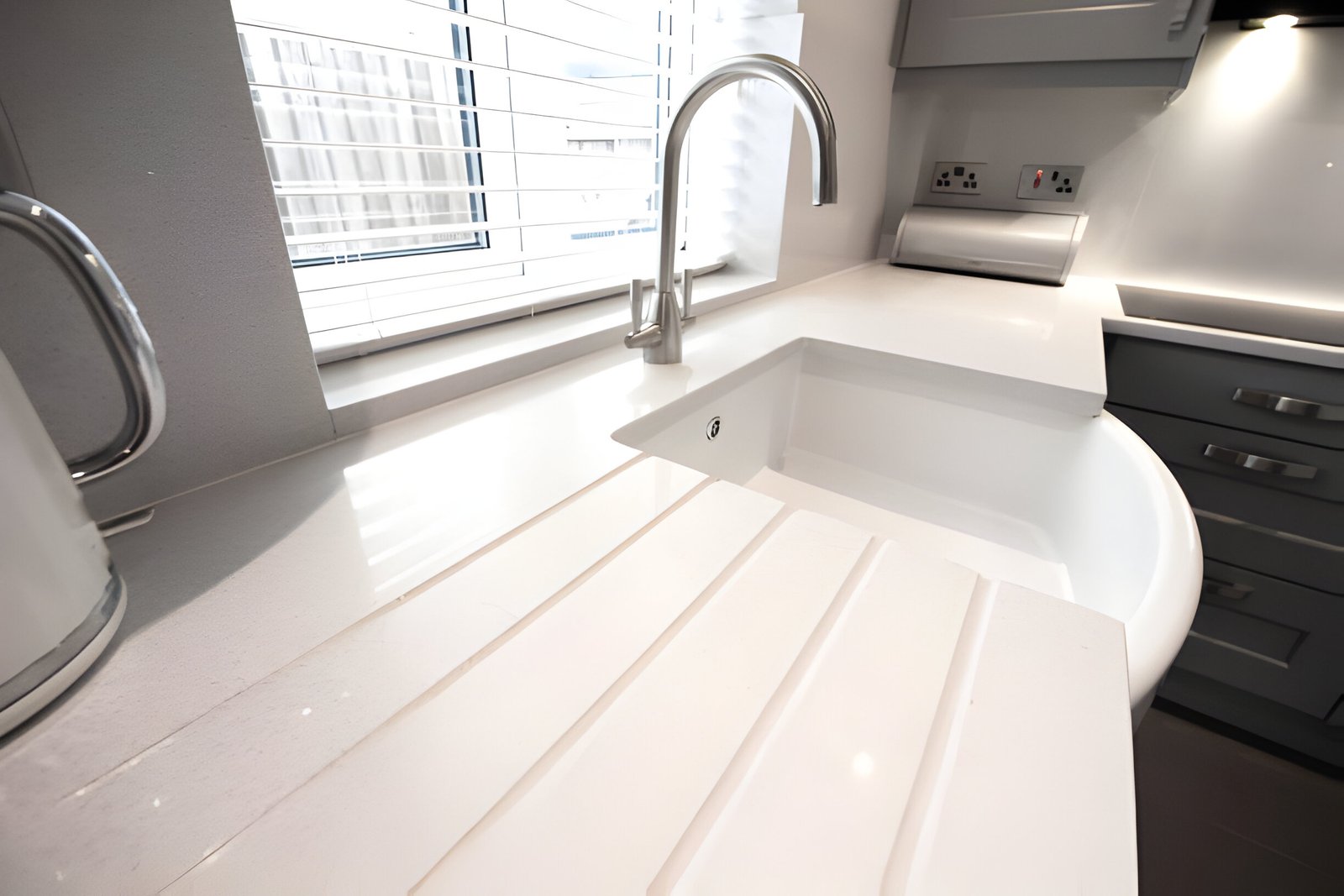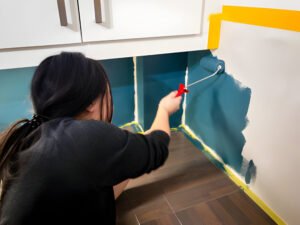Image Credit: Getty image
In the dynamic realm of home improvements and DIY solutions, the peel and stick countertop has emerged as a revelation for those seeking an affordable, yet aesthetically pleasing upgrade to their living spaces. This innovative solution leverages the convenience of countertop contact paper and a self-adhesive countertop laminate, offering a vast array of styles ranging from granite to faux marble, and concrete looks. The allure of such a quick fix is undeniable, providing homeowners with a temporary solution to revitalize kitchens and bathrooms without the hefty price tag or the hassle of a complete renovation.
This article delves into what peel and stick countertops are, highlighting their benefits such as their removable adhesive base that allows for hassle-free application and removal, making them an ideal temporary fix. It further explores the various applications and best uses, from covering a marble table top to creating a granite table top look, and how these vinyl-based films can transform surfaces into elegant, durable countertops. Whether you’re considering a temporary solution for a rental or a durable faux marble finish for your home, peel and stick countertop tiles offer a versatile, cost-effective alternative to traditional countertop materials.
What Are Peel and Stick Countertops?
Peel and stick countertops are an innovative and user-friendly option for updating kitchen and bathroom surfaces without the need for professional installation. These countertops are composed of a thin, flexible material that adheres directly to existing surfaces, simplifying the renovation process.
Materials and Composition
Typically crafted from durable materials like vinyl, laminate, or other synthetic composites, peel and stick countertops are designed to offer longevity and easy maintenance. They are resistant to stains, scratches, and heat, making them suitable for high-traffic areas. The base of most peel and stick countertops is made from PVC vinyl, onto which various patterns and images are printed, closely mimicking the appearance and texture of more expensive materials.
Variety of Styles and Patterns
The versatility in styles and patterns allows homeowners to choose from a wide range of aesthetics, including faux marble, granite, and even wood or concrete finishes. This variety ensures that individuals can easily match the new countertops with their existing home décor and personal style preferences. Whether the desired look is a classic solid color or a more elaborate design that resembles natural stone, peel and stick countertops provide an array of options to creatively enhance any space.
Benefits of Peel and Stick Countertops
Affordability and Cost-Effectiveness
Peel and stick countertops offer a significant cost advantage, making them an attractive option for those looking to update their kitchen or bathroom without a substantial financial investment. These countertops are not only affordable but also cost-effective, as they do not require professional installation, saving homeowners from additional labor costs.
Ease of Application and Removal
One of the standout benefits of peel and stick countertops is their ease of application. Homeowners can easily install these countertops themselves, which is a straightforward process involving peeling the backing and applying the material smoothly to avoid air bubbles. Removal is equally simple and typically does not damage the underlying surface, making it an ideal choice for temporary setups and rental properties.
Temporary and Flexible Solutions
Peel and stick countertops are perfect for those who prefer temporary or flexible design solutions. They can be easily removed and replaced, allowing for frequent updates to the decor without permanent commitment. This flexibility is especially beneficial for renters or individuals who enjoy changing their home’s aesthetics regularly without the need for long-term investment.
Applications and Best Uses
Peel and stick countertops are an excellent choice for various areas of the home, particularly where a quick and cost-effective solution is desired. They are ideal for temporary upgrades in rentals, as they can be removed easily without damaging the existing surfaces. This makes them perfect for renters who wish to personalize their space without permanent alterations. Additionally, these countertops are suitable for less frequented areas like basements or spare bathrooms, providing a fresh look with minimal effort and expense.
Ideal Rooms and Situations
Peel and stick countertops are most beneficial in situations where a temporary or low-cost solution is needed. For instance, they can cover old or worn-out countertops in kitchens and bathrooms, serving as an interim solution while saving for more permanent renovations. They are also practical in secondary parts of the home, such as laundry rooms or workshops, where aesthetics may be a priority but high durability is not critical.
Tips for Maximizing Durability
To ensure the longevity of peel and stick countertops, selecting a high-quality, thick material is crucial as it better withstands wear and conceals imperfections. During application, it’s advisable to have extra material on hand for any necessary adjustments and to use a squeegee to eliminate air bubbles, ensuring a smooth finish. For removal, applying heat with a hairdryer can ease the process, gently loosening the adhesive without leaving residues. Regular cleaning and cautious use, especially avoiding direct heat and sharp objects, will also help maintain the appearance and functionality of the countertops.
Conclusion
Throughout this exploration of peel and stick countertops, we’ve uncovered the affordability, ease of application, and versatility they offer as a DIY solution for updating and enhancing home spaces. Highlighting their benefits, from cost-effectiveness to the flexibility of style, peel and stick countertops stand out as a practical choice for those seeking to revitalize their kitchens and bathrooms without committing to the expenses and permanence of traditional renovations. These temporary yet durable upgrades provide homeowners and renters alike the freedom to experiment with their interior designs, making significant aesthetic changes that are both accessible and reversible.
Emphasizing the significance of these innovative materials, it’s clear that peel and stick countertops hold transformative potential for a variety of living spaces. By offering a blend of practicality and elegance, they cater to a wide array of design preferences and functional needs, making them an ideal option for anyone looking to refresh their home’s appearance on a budget. As we move towards more cost-effective and environmentally conscious decorating solutions, peel and stick countertops emerge not only as a trend but as a testament to the evolving landscape of home improvement, encouraging further exploration and adoption of such creative and flexible solutions.
FAQs
What is the simplest type of countertop to install by yourself?
Several DIY-friendly countertop options include faux granite, new laminate over existing laminate, solid surface countertops, pour-in-place concrete, resurfaced tile, painted faux marble using contact paper, and copper sheeting.
How can I inexpensively update my kitchen countertops?
You can revamp your old laminate countertops without breaking the bank by painting them, applying a faux-marble finish, covering them with contact paper, skim coating them with concrete, giving them a faux wood appearance, or using a stone-like finishing product.
What is the durability of peel and stick countertops?
Peel and stick countertops typically come with warranties that can last up to five years. However, in areas with heavy usage, these countertops may show wear and tear much sooner, depending on their quality.
Which countertop materials are the most budget-friendly?
The most affordable kitchen countertop materials include laminate (starting at $25 per square foot), solid surface (starting at $35 per square foot), granite (starting at $56 per square foot), butcher block, and quartz.
























+ There are no comments
Add yours